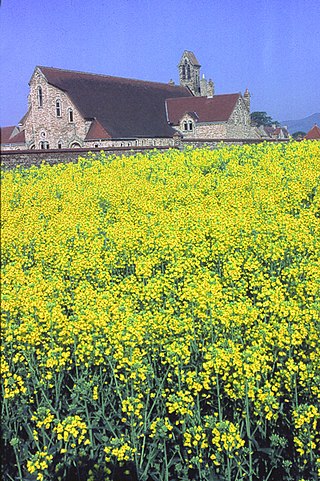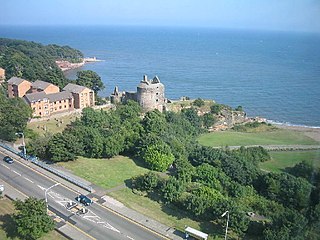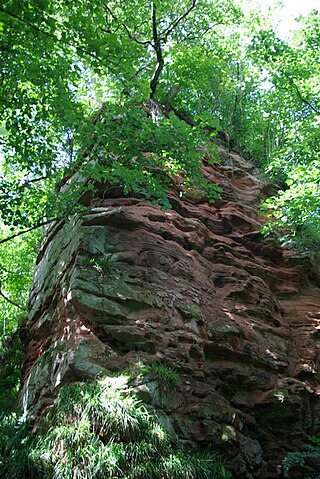
Midlothian is a historic county, registration county, lieutenancy area and one of 32 council areas of Scotland used for local government. Midlothian lies in the east-central Lowlands, bordering the City of Edinburgh council area, East Lothian and the Scottish Borders.

The Stirling council area is one of the 32 council areas of Scotland, and has a population of about 92,530. It was created in 1975 as a lower-tier district within the Central region. The district covered parts of the historic counties of Stirlingshire and Perthshire, which were abolished for local government purposes. In 1996 the Central region was abolished and Stirling Council took over all local government functions within the area.

Kilmarnock and Loudoun was one of nineteen local government districts in the Strathclyde region of Scotland from 1975 to 1996.

The River Esk, also called the Lothian Esk, is a river that flows through Midlothian and East Lothian, Scotland.

Roslin is a village in Midlothian, Scotland, 11 kilometres (7 mi) to the south of the capital city Edinburgh. It stands on high ground, near the northwest bank of the river North Esk.

Lasswade is a village and civil parish in Midlothian, Scotland, on the River North Esk, nine miles south of Edinburgh city centre, contiguous with Bonnyrigg and between Dalkeith to the east and Loanhead to the west. Melville Castle lies to the north east. The Gaelic form is Leas Bhaid, meaning the "clump at the fort."
Roslin Glen Country Park is a wooded glen in the North Esk Valley, near the village of Roslin in Scotland. It contains walks with several places of interest along the way, including Rosslyn Chapel, Roslin Castle, Wallace's Cave and Hawthornden Castle.

The Battle of Roslin on 24 February 1303 was a Scottish victory in the First War of Scottish Independence. It took place near the village of Roslin, where a force led by the Scots John Comyn and Sir Simon Fraser ambushed and defeated an English reconnaissance party under Lord John Segrave.

Roslin Castle is a partially ruined castle near the village of Roslin in Midlothian, Scotland. It is located around 9 mi (14 km) south of Edinburgh, on the north bank of the North Esk, only a few hundred metres from the famous Rosslyn Chapel.

Rosewell is a former mining village in Midlothian, Scotland, east of Roslin and south-west of Bonnyrigg. The village is in the civil parish of Lasswade and was previously a separate ecclesiastical parish, but has its own Community Council, namely Rosewell and District.

Cousland is a village in Midlothian, Scotland. It is located 4 kilometres (2.5 mi) east of Dalkeith and 3 kilometres (1.9 mi) west of Ormiston, on a hill between the Rivers Tyne and Esk.

Hawthornden Castle is located on the River North Esk in Midlothian, Scotland. The castle lies a mile to the east of Roslin at grid reference NT287637, and is just downstream from Roslin Castle. Hawthornden comprises a 15th-century ruin, with a 17th-century L-plan house attached. The house has been restored and now serves as a writer's retreat. Man-made caves in the rock beneath the castle have been in use for much longer than the castle itself.
The Bonnington Pavilion or Hall of Mirrors, now a ruin, is situated in the grounds of the old estate of Bonnington, near New Lanark, overlooking Corra Linn falls on the River Clyde in Lanarkshire, Scotland. Alternative names are the Corra Linn Pavilion and the Falls of Clyde summerhouse. It is said to have been the first Camera obscura built in Scotland. The name comes from the Gaelic 'currach', a marshy place. A legend gives 'Cora' as a daughter of King Malcolm II, who leapt to her death here whilst trying to escape imagined danger.

Ravenscraig Castle is a ruined castle located in Kirkcaldy which dates from around 1460. The castle is an early example of artillery defence in Scotland.

Torthorwald is a village and civil parish in Dumfries and Galloway, south-west Scotland. It is located 6 kilometres (3.7 mi) east of Dumfries on the A709 road to Lochmaben. The area was the property of the de Torthorwald family until the end of the 13th century, when the estate passed by marriage to the Kirkpatricks. In 1418, William de Carleil married the Kirkpatrick heiress. He may have been the builder of Torthorwald Castle, which was erected around this time, possibly on top of an earlier a motte. Torthorwald was erected as a burgh of barony in 1473. Torthorwald Castle was occupied until 1715; only two of its walls still stand, to a height of around 18 metres (59 ft).

Auchinleck Castle was a castle built on a rocky promontory on the eastern bank of the Lugar Water, East Ayrshire, Scotland across the river from Ochiltree Castle. It was built by the Auchinleck family in the 13th century.

Caprington Castle is a 15th century keep, incorporated in a castellated mansion, about 2 miles (3.2 km) south west of Kilmarnock, East Ayrshire, Scotland, south of the River Irvine.

Wallace's Cave in the Lugar Gorge at Auchinleck in the Parish of Auchinleck, East Ayrshire is an 18th-century grotto, contemporary with Dr Johnson's Summerhouse which is also located on the Auchinleck Estate. It shows superior workmanship and is possibly the enlargement of a pre-existing cave. The cave or grotto lies downstream of the confluence of the Dippol Burn with the River Lugar and is reached via a once well formed path; however access is now hazardous due to the condition of the cliff edge path and the vertical drop into the River Lugar.
Gorton is a locality, in the parish of Lasswade, in Midlothian, Scotland.
















